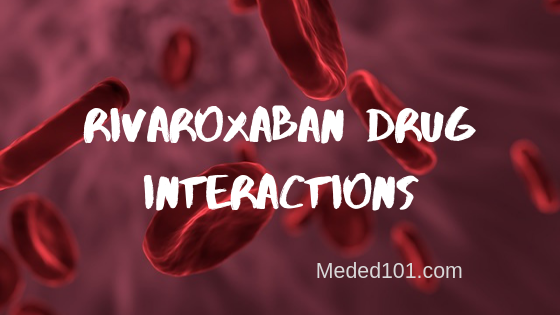One of the big advantages of newer agents like rivaroxaban is there’s less potential for diet and drug interactions than with warfarin. Now that doesn’t mean that there aren’t any rivaroxaban drug interactions. We have to pay attention to these agents, and I’m going to give you some examples of meds that we really need to pay attention to. (Rivaroxaban Package Insert)
These rivaroxaban drug interactions are things that I think are highly important, or I have seen in clinical practice cause an issue so with that stated the list is definitely not all-inclusive. If you aren’t sure if there is an interaction between agents, you need to look it up. Always.
Dual P-Glycoprotein and CYP3A4 Inhibitors
Avoiding the use of rivaroxaban is recommended in patients on dual inhibitors of p-glycoprotein and CYP3A4. What are these drugs you ask? Here are a few examples, and you will probably notice that these drugs aren’t used crazy often.
- Ketoconazole
- Itraconazole
- Ritonavir
CYP3A4 Inducers
Avoiding the use of CYP3A4 inducers with rivaroxaban is also recommended.Carbamazepine is a medication that I do see used occasionally. Phenytoin, rifampin, and primidone are also other agents that I see used from time to time. Keep an eye out for these as they will actually lower concentrations of the rivaroxaban, and potentially lead you down the path of treatment failure, increasing the risk of stroke by not having adequate concentrations.
Saint John’s wort is an OTC supplement and has CYP3A4 induction capability.
Rivaroxaban Drug Interactions – Miscellaneous
It is kind of a no-brainer that a patient should not be receiving multiple anticoagulants, but I will say I have seen this mistake made more than once in my career. Barring some sort of transition, a patient should never be on rivaroxaban and warfarin, or rivaroxaban and apixaban, etc.
With bleeding risk, I’m always concerned about patients who are receiving antiplatelet medications with their anticoagulant. This is something that needs to be watched closely and I always try to ask these patients if they are having any signs and symptoms of bruising or bleeding.
NSAIDs are absolutely discouraged because of their ability to insult the GI tract as well as their antiplatelet activity. GI bleed risk goes up substantially when anticoagulation is used with an NSAID.
- 30 medication mistakes PDF
- 18+ Page Drug Interaction PDF
- 10 Commandments of Polypharmacy Webinar based on my experiences in clinical practice



Thoughts when you have a patient on both an inducer and inhibitor concurrently?
Anyone’s guess as to what might happen…depends upon the strength of induction/inhibition.
Hi;
How about the dose of these medications? For example primidone 125 mg daily for essential tremor in patient with AF who takes rivaroxaban 15 mg daily (GFR=34 ml/min)